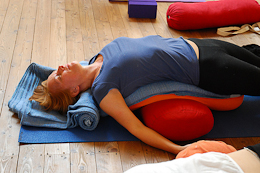Injury-Related Iyengar Yoga
Iyengar is one of the most popular and beneficial types of yoga for those recovering from an injury. As Iyengar is known for its heavy use of equipment and other support devices, this style minimizes the risk of further injury for participants. Such equipment not only make it easier for each pose to be performed correctly, but also help make it an ideal type of yoga not just for those recovering from an injury, but for those that may not have the flexibility that they enjoyed when they were younger. By using the various pieces of equipment and devices, individuals will not only be better able to hold each of the poses, but improve the range of motion when performing each of the poses as well. Iyengar yoga is named after its founder, B.K.S. Iyengar, who introduced his approach to yoga when he began teaching in 1937. Today, Iyengar is considered one of the foremost yoga instructors in the world. Types of MovementsDepending on your injury, there may be several different types of movements involved in your specific approach to injury-related Iyengar yoga. Most injury-related yoga poses will strengthen the your body's core, or strengthen uninjured areas of your body to help support injured ones. Poses designed to increase flexibility can also limit the risk of a further injury or worsening of pain associated with an existing injury. Some professional athletes use Iyengar yoga to both recover from injuries and decrease the risk of injuries in the future. For example, Ryan Giggs, a professional soccer player for Manchester United FC regularly practices Iyengar yoga. Mental and Physical RequirementsMental and physical requirements of injury-related Iyengar yoga are minimal. This type of yoga is specifically designed to accomodate any level of student and physical condition, as asanas (or poses) can be adjusted based on a person's level of recovery following an injury. In fact, the founder of Iyengar yoga brought widespread recognition to the yoga style by working specifically with a few students that were recovering from myocardial infarctions, serious heart malfunctions. Props help students overcome almost any physical disability to perform a set of yoga poses. Mentally, you must be open to critique and correction. As Iyengar yoga classes are very vocal and mistakes are often immediately corrected, you should have a tough skin before attending your first injury-related Iyengar yoga class. Although teachers are almost always gentle and helpful, this type of yoga requires close attention to detail in every pose. Equipment Requirements
Mental and Physical BenefitsMental
Physical
Aerobic Effect
Iyengar yoga, especially for injury relief and prevention, is not intended to provide an aerobic effect as most movements are performed a in slow and deliberate manner. However, an increased level of focus is placed on the perfection in each movement and position as opposed to moving quickly between poses or a series of poses. Participants that have incurred an injury and are specifically practicing injury-related Iyengar yoga for that reason will assist their injury in healing while reducing the probability of aggravating or sustaining additional damage. This is an important first step in healing an injury and should be performed before resuming aggressive strength and cardiovascular exercises. Iyengar yoga for injuries has been the subject of several well-publicized studies, including one performed by Dr. Sharon Kolasinski. In this study, a11 patients suffering from symptoms related to osteoarthritis of the knee were asked to attend a weekly 90 minute session of injury-related Iyengar yoga. At the conclusion of the study, all of the participants reported decreased pain and disability in their knees. |
Copyright © 2025 FitnessHealth101.com All Rights Reserved
FITNESS TOPICS
FITNESS REVIEWS
FITNESS & HEALTH GLOSSARIES

